
Everton FC
An updated version of the crest was used for 2013/14 but this proved unpopular with supporters so a wide-ranging consultation exercise was undertaken which resulted in the production of three new crests. These were put to a fan vote and the current crest was the overwhelming winner. It was introduced formally in July 2014. Therefore, in 2014, the management kept a promise and changed the emblem to a new-old design. The name of the club and the year of its foundation were moved to the middle of the shield, under the tower. The emblem was made in a two-color version (blue and white).
Everton FC Primary Logo
Everton Football Club is one of the most iconic and successful clubs in English football. The Toffees have been around since 1878, and they have a rich history that has seen them become one of the most recognizable teams in all of Europe. One symbol that has been with Everton throughout its entire history is its primary logo. This logo has gone through many changes over the years, each reflecting different eras for the club.
The current version of Everton's primary logo was introduced in 2014 as part of a rebranding effort by then-owner Bill Kenwright to modernize and update its identity while still maintaining ties to its past logos. It features an updated version of "The Tower" crest which had been used on some previous versions, but it also incorporates elements from other classic designs such as stars representing each major trophy won by Everton (the FA Cup five times), along with laurel leaves symbolizing success and glory surrounding “EFC” written at a center stage within an oval shape shield - this design element being taken from earlier crests used between 1938–1973 & 1973-1978 respectively. Additionally, there are two lions flanking either side; these were first added during a redesign process undertaken prior to the 1978/79 season based on suggestions made by supporters who wanted something more regal than what was previously being displayed on team jerseys at the time - hence why Lions became de facto choice when it came incorporating new visual into badge itself.
Overall, the primary Logo for FC Everton not only serves the purpose of reminding us about the prestigious heritage associated with the Club but also gives fans a sense of belonging whenever they see familiar imagery represented across various platforms; whether be merchandise or matchday programs, etc... In short, it encapsulates everything great about Toffees both present-day future ensuring we always remember our roots no matter how far may take us!

Everton FC
2013 - 2014
May 25, 2013, Everton announced the change of logo, but in two days, more than 14 thousand fans signed an online petition asking the leadership not to touch the emblem. The new logo lacks the club’s motto, which had been represented there since 1938, as well as a pair of wreaths, the long-standing symbol of Everton. The leadership of the club gave credence to their fans and in several days announced that this emblem will be used only for one season. The reason for such decision is that the new version had already been put into production.
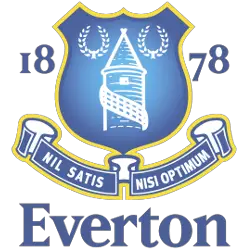
Everton FC
2000 - 2013
In 2000, following the trends of contemporary design, the club changed some colors and added a wordmark. Also, added the year of the club formation "1878," dividing it into 2 and placing on both sides of the shield. In addition, the wordmark “Everton” appeared under the motto of the club.
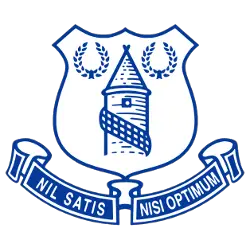
Everton FC
1991 - 2000
A white with blue trim shield with the tower centered and on either side is the laurel wreathes in blue. Under the shield, there was an inscription in Latin “Nil Satis Nisi Optimum”, which means “Only the best is good enough.”
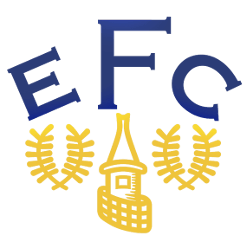
Everton FC
1983 - 1991
Everton's next crest has letters "EFC" in blue above a slightly reshaped Tower and laurel wreathes in yellow.
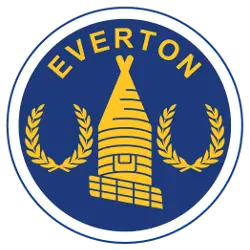
Everton FC
1982 - 1983
In 1982, a simplified, circular design was produced, with the shield and the Latin motto removed. In yellow is the tower and two laurel wreaths with an arched wordmark above "EVERTON" on a blue with white trim.
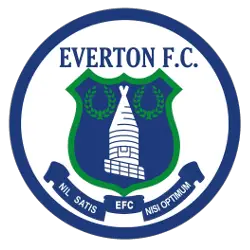
Everton FC
1978 - 1982
In 1978, came the return of the Tower. This was the first time Kelly's design had been used on the kit and it remained for four years. At the top of a white with blue trim circle background is a wordmark "EVERTON F.C." in blue. Under the shield, there was an inscription in Latin “Nil Satis Nisi Optimum”, which means “Only the best is good enough.”

Everton FC
1976 - 1978
Here is the simplified font for the 1976 emblem "EFC" letter in blue.

Everton FC
1972 - 1976
There was no crest of any type on the Everton jersey until 1972, when white ‘EFC' letters were simply embroidered onto the shirt. This lasted for four seasons before a simplified font was introduced instead.
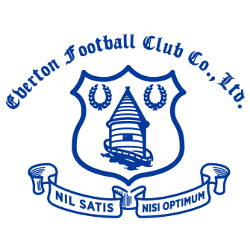
Everton FC
1938 - 1972
At the end of the 1937/38 season, Everton’s secretary Theo Kelly, who later became the head coach of the club, decided to design a new club logo. In Everton, the district of Liverpool, you won’t find a building older than the Prince Rupert’s Tower, built in the late eighteenth century. Therefore, designers decided to put this image on the club’s emblem. Near this, they added two laurel wreaths, enclosed in a shield, symbolizing victory. Under the shield, there was an inscription in Latin “Nil Satis Nisi Optimum”, which means “Only the best is good enough.” For the first time, the Everton’s logo was demonstrated in 1939.
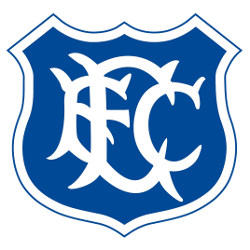
Everton FC
1920 - 1938
The first official Everton logo was introduced in 1920. It consisted of interwoven custom font "EFC" letters in white color, which were located on top of the shield with a blue with white trim background.
College Sports Fan Products




























